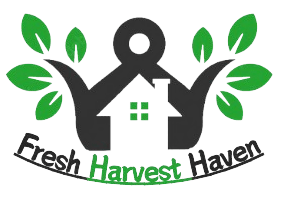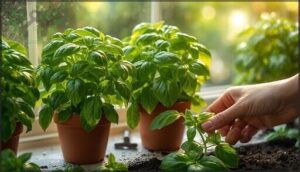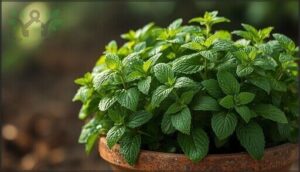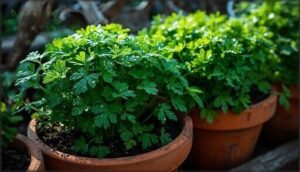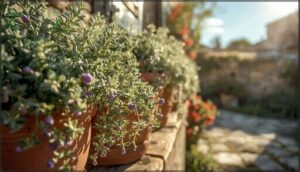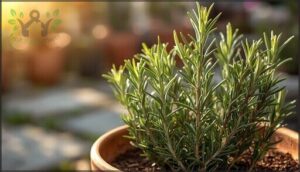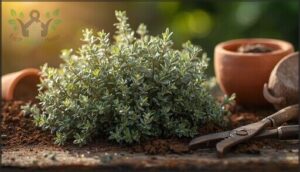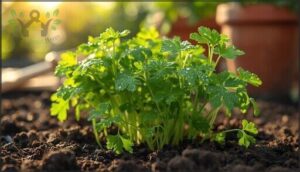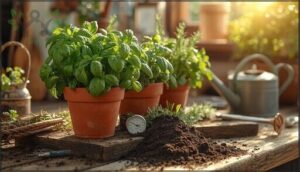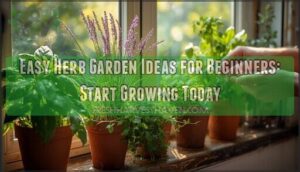This site is supported by our readers. We may earn a commission, at no cost to you, if you purchase through links.
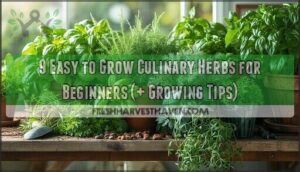
These easy-to-grow culinary herbs don’t just survive beginner errors; they reward them with vigorous growth and bold taste. Whether you’re working with a sunny windowsill or a sprawling garden bed, starting with herbs that actually want to succeed changes everything.
The difference between a wilted disappointment and a thriving kitchen garden often comes down to choosing plants that match your space, schedule, and skill level—not trying harder with the wrong ones.
Table Of Contents
- Key Takeaways
- Top Easy-to-Grow Culinary Herbs
- Basil – Fast-Growing Annual for Beginners
- Mint – Hardy Perennial for Containers
- Chives – Versatile and Low-Maintenance
- Parsley – Resilient and Productive
- Oregano – Robust Mediterranean Favorite
- Rosemary – Woody and Drought-Tolerant
- Thyme – Compact and Aromatic
- Cilantro – Quick-Growing and Flavorful
- Dill – Feathery Herb for Multiple Dishes
- Ideal Growing Conditions for Culinary Herbs
- Growing Culinary Herbs Indoors and Outdoors
- Herb Care and Maintenance Tips
- Using Fresh Herbs in Cooking
- Frequently Asked Questions (FAQs)
- What herbs are easy to grow in the kitchen?
- What are the best culinary herbs to grow?
- Which herb is the easiest to grow?
- What is a fast-growing edible herb?
- Which is the easiest herb to grow?
- What herbs are low maintenance to grow?
- What is the mother of all herbs?
- How can I preserve herbs for later use?
- What herbs grow well in cold climates?
- Which herbs attract pollinators like bees or butterflies?
- Conclusion
Key Takeaways
- Choose beginner-friendly herbs like basil, mint, chives, and oregano that forgive mistakes and thrive with minimal attention rather than struggling with finicky varieties that demand perfect conditions.
- Most culinary herbs need 6-8 hours of direct sunlight daily and well-draining soil with a pH between 6.0-7.0, but shade-tolerant options like mint and parsley work when light is limited.
- Regular pruning above leaf nodes triggers bushier growth and can boost your harvest by up to 35%, while proper technique means never removing more than one-third of the plant at once.
- Fresh herbs pack concentrated antioxidants, vitamins, and medicinal compounds that support immune health and reduce inflammation—making your windowsill garden a nutritional powerhouse, not just a flavor source.
Top Easy-to-Grow Culinary Herbs
You don’t need a green thumb to grow your own culinary herbs—just a little sunlight and the right starter plants. These nine herbs are forgiving, productive, and perfect for anyone who’s new to gardening.
Whether you’re working with a windowsill or a backyard plot, these picks will give you fresh flavor without the fuss.
Basil – Fast-Growing Annual for Beginners
Basil delivers big flavor fast, making it perfect for first-time herb growers. Plant Genovese, Thai, or Lemon varieties two weeks after your last frost—they’ll thrive in warm soil with good drainage and 6-8 hours of sun.
Pinch off top leaves regularly to prevent flowering and boost your harvest. Water deeply when the top inch feels dry, and watch for aphids by checking leaf undersides weekly.
For ideal growth, understanding basil plant care is essential.
Mint – Hardy Perennial for Containers
Mint thrives where other herbs give up—cold winters down to -20°F won’t stop this aggressive perennial. Grow it in a 10-inch container with drainage holes to contain its spreading rhizomes, and you’ll harvest about a pound every four square feet once it matures.
- Water daily during hot weather to keep soil moist but never soggy
- Place containers in full sun or afternoon shade in hotter climates
- Pinch stems before flowering to encourage bushier growth and stronger flavor
To guarantee healthy growth, consider using a premium potting mix for your mint plants.
Chives – Versatile and Low-Maintenance
Unlike mint’s wild ambitions, chives stay put—thriving in containers or garden beds without staging a takeover.
You’ll harvest your first batch just 30 days after transplanting, cutting leaves down to 2 inches every few weeks. They laugh off aphids and diseases, need fertilizer only once or twice per season, and tolerate cold down to -20°F.
Perfect for easy-to-grow herbs and container herb gardening without the fuss.
Parsley – Resilient and Productive
Parsley thrives where others struggle—both flat-leaf and curly varieties tolerate partial shade, bounce back from neglect, and produce for months. You’ll want soil pH between 6.0 and 7.0, watering once or twice weekly when the top inch feels dry.
Light nitrogen fertilizing and quick pest control keep this culinary herb pumping out fresh leaves for your kitchen adventures.
Oregano – Robust Mediterranean Favorite
This Mediterranean powerhouse laughs in the face of neglect—oregano thrives in zones 4-10, resists drought like a champion, and delivers that bold, pungent kick your dishes crave. You’re looking at a herb that practically grows itself:
- Full sun exposure (6-8 hours) triggers maximum flavor compounds
- Well-draining soil with pH 6.0-8.0 prevents root issues
- Weekly watering once established keeps it thriving
Your pizza and pasta deserve this rebellious flavor bomb.
Rosemary – Woody and Drought-Tolerant
With rosemary, you’re commanding a drought-tolerant woody warrior that demands soil pH between 6.0 and 7.0 for ideal growing. This culinary herb thrives on 6-8 hours of sunlight while laughing off dry spells—its chemical compounds like 1,8-cineole deliver both flavor and impressive health benefits.
Propagation methods are straightforward: stem cuttings root at 75-85% success rates. Master these herb growing tips, and you’ll reveal flavors that defy ordinary cooking.
Thyme – Compact and Aromatic
You’re about to grow one of the toughest culinary herbs on the planet. Thyme varieties pack aromatic compounds like thymol into plant dimensions of just 6-12 inches, making them perfect rebels for tight spaces. Growing conditions? They laugh at drought and poor soil.
Master these herb growing tips for thyme:
- Full sun exposure: 6-8 hours daily for peak herb flavor profiles
- Soil pH 6.0-8.0: Alkaline-friendly with excellent drainage
- Minimal watering: Drought-tolerant once established
- Spring pruning: Remove one-third after flowering
- Harvest timing: Cut top 5-6 inches before blooms appear
These care practices foster serious growing herbs momentum.
Cilantro – Quick-Growing and Flavorful
Want flavor in 7-10 days? Cilantro delivers blazing seed germination at best pH 6.2-6.8. This easy-to-grow rebel excels in culinary herbs with a citrusy punch—unless you’re among the 4-14% who taste soap instead.
Your beginner gardening guide: plant seeds 1/4-inch deep, harvest leaves within 45-70 days, and beat cilantro bolting by growing herbs in cooler temps to prevent flavor loss.
Dill – Feathery Herb for Multiple Dishes
Dill’s feathery foliage and bright flavor transform pickling, fish dishes, and potato salads—your garden’s multi-purpose herb that practically runs itself.
You’ll harvest leaves in 40-60 days while seeds mature around 90 days in well-draining soil (pH 5.8-6.5) with 6-8 hours of sunlight. Dill varieties thrive between 68-100°F.
Preserve both leaves and seeds by drying or freezing for year-round culinary herb uses.
Ideal Growing Conditions for Culinary Herbs
Growing herbs successfully isn’t complicated, but you need to get a few basics right from the start. Think of it like setting up the perfect workspace—your herbs need the right light, soil, water, and temperature to thrive.
Let’s break down exactly what these kitchen favorites need to flourish on your windowsill or in your garden.
Sunlight Requirements for Common Herbs
Most culinary herbs crave full sun—at least 6 hours of direct sunlight daily—to develop bold flavors and vigorous growth. Light intensity directly impacts herb quality, influencing essential oil production and leaf thickness. However, you’ve got options:
- Full sun lovers: Basil, rosemary, oregano, and thyme thrive with 6+ hours of sunlight exposure.
- Partial sunlight adapters: Cilantro and parsley tolerate 4-6 hours.
- Shade tolerance champions: Mint and chives handle 3-4 hours comfortably.
- Flexible growers: Most herbs adjust to partial shade, though growth slows slightly.
Understanding sunlight requirements for herbs unlocks better harvests and richer flavors.
Best Soil Types and Drainage Needs
Sunlight sets the stage, but soil composition seals the deal. You’ll want well-drained soil with a pH between 6.5 and 7.0—this sweet spot unlocks nutrient availability and boosts flavor.
Mix one-third compost, one-third peat or coir, and one-third perlite for ideal water retention and drainage.
Proper drainage methods prevent root rot, maintaining root health by keeping oxygen flowing to hungry roots.
Watering Techniques to Prevent Overwatering
You’ve nailed the soil mix—now water smart to keep those roots breathing. Check soil moisture by sticking your finger two inches down; if it’s dry, it’s time. Water deeply once or twice weekly, letting excess drain completely through those drainage holes.
Herbs like rosemary need less, while basil prefers consistent moisture. Bottom watering prevents leaf diseases and encourages stronger roots downward.
Temperature and Humidity Considerations
Keep growing conditions steady for herbs to thrive. Ideal temperatures sit between 65°F and 75°F for most varieties—basil loves warmth above 70°F, while rosemary tolerates cooler ranges. Cold tolerance varies—mint survives light frosts, but basil wilts below 50°F.
Watch humidity risks: anything over 70% invites powdery mildew and fungal trouble. Indoor ventilation helps control soil moisture and prevents disease. Adjust watering techniques for herbs as seasonal changes shift your indoor herb cultivation game.
Growing Culinary Herbs Indoors and Outdoors
You don’t need a sprawling backyard to grow your own herbs—just a bit of creativity and the right setup for your space. Whether you’re working with a sunny windowsill, a balcony corner, or an actual garden bed, herbs adapt surprisingly well to different environments.
Let’s break down your options so you can start growing fresh flavor wherever you’re.
Container Gardening for Small Spaces
You don’t need a sprawling backyard to grow herbs at home—container gardening turns balconies and windowsills into productive spaces. Urban adoption is soaring as people discover how easy-to-grow herbs thrive in terracotta pots, fabric grow bags, or recycled mason jars.
Choose containers with proper soil drainage, fill them with well-aerated potting mix, and you’ve got a herb garden for small spaces that delivers fresh flavor on demand.
Indoor Herb Gardens and Grow Lights
When sunlight is scarce, LED efficiency changes everything—these grow lights slash energy use by 50-70% while delivering the full light spectrum your indoor herb garden craves.
You can set up hydroponics integration or vertical gardening systems under automation-controlled LEDs, transforming any dim corner into a productive growing space.
Indoor plants thrive year-round, even without a sunny windowsill, giving you total freedom from seasonal limits.
Outdoor Planting in Beds and Planters
With sunny, well-draining sites and proper soil preparation, you’ll gain freedom in herb garden design. Aim for 6-8 hours of sunlight exposure daily and incorporate compost to boost drainage solutions—your container selection matters, too.
Easy-to-grow herbs like basil, rosemary, and thyme thrive outdoors when you follow these herb growing tips. Growing herbs at home means embracing pest control early, protecting your investment from day one.
Seasonal Care and Overwintering Herbs
As winter arrives, your perennial herbs need strategic protection while annual herbs won’t survive the cold—but don’t let that stop you from keeping fresh flavors within reach.
- Indoor herb lighting: Place rosemary and thyme under grow lights for 4-6 hours daily when growing herbs indoors
- Outdoor protection methods: Shield sage and oregano with cold frames or heavy mulching
- Overwintering watering needs: Water sparingly, only when the top two inches feel dry
- Winter herb hardiness: Zones 4-10 herbs survive outdoors with proper herb care and maintenance
Herb Care and Maintenance Tips
Once your herbs are growing, the real fun begins—keeping them healthy and productive without overthinking it. A few simple habits like strategic pruning, smart feeding, and knowing when to harvest can make the difference between scraggly plants and a thriving kitchen garden.
Let’s break down the essentials that’ll keep your herbs happy and your meals full of flavor.
Pruning for Bushier Growth
Want a lush, full herb garden that keeps giving? Regular pruning is your secret weapon. When you trim growth tips above a node, you trigger dormant buds to wake up—boosting lateral branches by up to 40% and increasing your harvest by 35%.
Here’s how pruning frequency and technique reshape your herbs:
| Herb Type | Pruning Frequency | Method |
|---|---|---|
| Basil, Mint | Every 2–3 weeks | Pinch tips above nodes |
| Oregano, Thyme | Monthly | Remove up to 1/3 of growth |
| Rosemary, Sage | Every 4–6 weeks | Trim woody stems lightly |
The hormonal impact is real: cutting tips suppresses auxin and activates cytokinins, prompting bushier regrowth within 3–7 days. For regeneration safety, never remove more than one-third of your plant at once—this keeps stress low and yields high.
Fertilizing for Flavor and Health
Fertilizing isn’t just about growth—it’s the difference between flat herbs and flavor-packed ones. Too much nitrogen dilutes essential oils, while the right balance keeps aromas intense and nutritional value high.
- Organic vs. Synthetic: Organic fertilizers boost vitamin C and cut toxic nitrates
- Fertilizer Frequency: Feed nutrient-lovers 1–2 times per season; indoor herbs every 2–6 weeks
- Flavor Impact: Limit phosphorus to 5–10 mg/L to preserve oil concentration
- Optimal pH: Keep soil conditions between 5.8–6.2 for nutrient uptake
- Micronutrient Management: Balance calcium, magnesium, and iron for vigorous health
Preventing Pests and Diseases
Protecting your herbs doesn’t mean reaching for harsh chemicals. IPM strategies combine natural controls—like hand-picking pests and planting mint nearby—with cultural controls such as proper spacing and avoiding overhead watering.
These pest control methods slash aphid outbreaks by 38% and fungal disease by 41%. When plant diseases strike, quick removal of affected parts preserves plant health.
It’s smart pest control that keeps your kitchen garden thriving naturally.
Harvesting Techniques for Maximum Yield
Once pests are under control, your reward begins. Harvest herbs for cooking in the morning after dew dries—that’s when flavor oils peak.
Snip just above a leaf node with sharp, clean pruners; this cutting method triggers two new stems per cut, doubling your future bounty. You can take up to 75% of foliage without harm, and these easy to grow culinary herbs bounce back fast with proper herb harvesting techniques.
Using Fresh Herbs in Cooking
Growing your own herbs is just the beginning—the real magic happens when you bring them into the kitchen. Fresh herbs can completely transform your cooking, adding bold flavors and vibrant aromas that dried versions simply can’t match.
Let’s explore how to make the most of your homegrown harvest, from pairing herbs with the right dishes to preserving them for year-round use.
Flavor Profiles and Pairing Suggestions
Flavor profiles reveal your culinary rebellion—each herb brings distinct compounds that transform ordinary meals into bold experiences. Understanding herb flavor intensity and how savory herb pairings work helps you break free from bland cooking with herbs that genuinely elevate dishes.
- Basil’s clove-like eugenol pairs beautifully with tomatoes in 67% of pesto recipes, offering sweet herb pairings for grilled chicken
- Mint’s 1.2% menthol content amplifies chocolate desserts and yogurt-based dishes with invigorating coolness
- Oregano’s powerful carvacrol matches cheese and tomato in 73% of pizza recipes
- Cilantro’s citrus aldehydes brighten 78% of Mexican salsas
- Dill’s carvone naturally complements cucumbers in pickling
Culinary Uses in Salads, Soups, and Drinks
Once you’ve mastered herb flavor pairings, it’s time to use them freely in your kitchen. Basil transforms 50% of salads with aromatic sweetness, while rosemary and thyme support hearty soups. Mint cools 40% of herbal drinks and teas, offering digestion support. Fresh herbs slash sodium by 25% without losing flavor—your ticket to bolder, healthier meals.
| Dish Type | Top Herb Choices |
|---|---|
| Salads | Basil, parsley, cilantro |
| Soups | Rosemary, thyme, oregano |
| Drinks | Mint, chamomile, citrus herbs |
Preserving Herbs by Drying or Freezing
When your harvest overwhelms your kitchen, don’t let those herbs go to waste. Drying herbs concentrates flavor but can lose up to 40% of aroma—dehydrators at 95-110°F preserve more than air-drying.
Freezing techniques retain over 85% of antioxidant levels and nutritional value. Chop herbs, freeze in oil, and you’ll lock in aroma retention that beats any spice rack.
Health Benefits and Nutritional Value
Fresh herbs pack antioxidant effects and vitamin contributions that transform your meals into medicine. You’re not just adding flavor—you’re fueling immune support, steadying blood sugar, and protecting your heart with every snip. Here’s the nutritional value hiding in your windowsill:
Fresh herbs deliver powerful antioxidants and vitamins that fuel immune support, steady blood sugar, and protect your heart with every bite
- Basil delivers polyphenols that neutralize free radicals and may lower glucose levels.
- Parsley supplies 154% daily vitamin K in just two tablespoons.
- Oregano ranks highest in antioxidants among culinary herbs.
- Mint provides 30% of your vitamin C needs per serving.
- Chives contain quercetin, reducing blood pressure and heart disease risk.
These medicinal herbs prove that herbs for health aren’t just folklore—they’re your kitchen’s secret weapon for well-being.
Frequently Asked Questions (FAQs)
What herbs are easy to grow in the kitchen?
Chives, mint, parsley, oregano, and thyme top beginner herb choices for kitchen gardens. These low-effort herbs adapt to containers, demand minimal care, and deliver fresh flavor fast—perfect for indoor herb success.
What are the best culinary herbs to grow?
You won’t need a green thumb when you choose beginner-friendly herbs based on your flavor profile and space constraints—basil, mint, chives, parsley, oregano, rosemary, thyme, cilantro, and dill consistently deliver.
Which herb is the easiest to grow?
Mint wins as the easiest herb for beginner gardening guide enthusiasts—this low-effort gardening champion tolerates shade, spreads vigorously with 98% propagation success, and thrives in containers.
It’s incredibly forgiving, making growing herbs for beginners nearly foolproof.
What is a fast-growing edible herb?
You don’t need weeks of waiting—basil leads the pack with germination speed and a harvest timeline of just 25–30 days. Arugula follows close behind, while growth factors like sunlight accelerate economic yields dramatically.
Which is the easiest herb to grow?
For a beginner gardening guide, consider chives. With over 90% survival rates and minimal fuss, they’re your ticket to herb growing success—even in low light or less-than-perfect soil.
What herbs are low maintenance to grow?
For low maintenance, go with drought-tolerant herbs like rosemary and oregano—they survive weeks without water and thrive on neglect.
Hardy perennial herbs such as thyme and chives are pest-resistant, making them perfect beginner herb choices.
What is the mother of all herbs?
In medieval Europe, mugwort earned the title “mother of herbs” for its wide-ranging medicinal uses. Today, Tulsi holds sacred status in Ayurvedic tradition, revered for over 3000 years.
How can I preserve herbs for later use?
You can preserve herbs through drying techniques, freezing methods, oil infusions, salt preservation, and pesto creation. These herb harvesting techniques extend shelf life while maintaining flavor, letting you enjoy your harvest year-round.
What herbs grow well in cold climates?
You’ll find resilient plants thrive where others falter: chives, thyme, oregano, and mint all boast impressive temperature tolerance.
Cold-hardy herbs survive harsh winters with simple frost protection and smart overwintering strategies.
Which herbs attract pollinators like bees or butterflies?
Many herb varieties become nectar-rich magnets when they flower. Bee-friendly herbs like thyme, rosemary, and oregano draw pollinators with their abundant blooms, while butterfly-attracting herbs like lavender and mint transform your herb garden into a buzzing haven.
Conclusion
Growing easy-to-grow culinary herbs isn’t about flawlessness—it’s about picking plants that thrive on simplicity, forgive your mistakes, and deliver bold flavors without drama. Start with one or two forgiving favorites, give them decent light and drainage, and let them prove how little they need.
Before long, you’ll be pinching fresh basil for dinner, snipping chives without thinking twice, and wondering why you ever hesitated. Your kitchen garden starts with choosing herbs that actually want to grow.
- https://www.tastingtable.com/1901997/most-basil-which-country/
- https://www.futuremarketinsights.com/reports/basil-leaves-market
- https://hdoa.hawaii.gov/add/files/2024/10/Basil-Stats-2023-_SOH_10.31.24.pdf
- https://www.motherearthliving.com/gardening/plant-profile/A-Basil-Harvest/
- https://svaec.ifas.ufl.edu/media/svaecifasufledu/docs/pdf/svreports/greenhousehydroponics/99-06.pdf
